


The article "10 Key Insights for Successful Phase 2 Clinical Testing" centers on outlining essential strategies and considerations for the effective conduct of phase 2 clinical trials. It underscores critical factors such as:
These elements are pivotal for enhancing the efficiency and success of phase 2 testing processes.
The landscape of clinical testing is rapidly evolving, particularly in the critical Phase 2 trials that bridge the gap between initial safety assessments and larger-scale efficacy evaluations. As the demand for innovative treatments intensifies, understanding the nuances of Phase 2 clinical testing becomes paramount for researchers and stakeholders alike. This article delves into ten key insights that illuminate best practices, strategies, and emerging trends essential for navigating the complexities of Phase 2 trials. How can researchers leverage these insights to enhance success rates and streamline processes in an increasingly competitive environment?
bioaccess® leverages the regulatory pace of Latin America, the diverse patient demographics in the Balkans, and Australia's efficient ethical approval procedures to dramatically shorten the timelines for phase 2 clinical testing. With ethical approvals secured in just 4-6 weeks—significantly faster than the average of 48 days for Medtech studies—and participant enrollment rates that are 50% quicker than traditional markets, bioaccess® empowers innovators to expedite their research effectively.
This agility is essential for sustaining a competitive advantage in the dynamic Medtech, Biopharma, and Radiopharma sectors, where timely advancements can profoundly influence market success. Furthermore, Colombia provides R&D tax incentives, offering a 100% tax deduction for investments in science and technology, making it a financially attractive option for conducting experiments.
As the number of registered medical studies worldwide is expected to increase by 2025, the ability to navigate these complexities not only enhances the efficiency of research processes but aligns with the industry's growing demand for rapid and reliable research outcomes. As industry specialists assert, 'the efficiency and effectiveness of their approach are clear,' underscoring the critical role of regulatory speed in medical studies.

Phase 2 clinical testing plays a pivotal role in evaluating the effectiveness and safety of treatments among a larger participant group, typically consisting of 25 to 100 individuals. Phase 2 clinical testing is essential for determining whether a treatment meets its intended objectives and for identifying potential side effects. For example, the Phase 2 study of ION224, which involved 160 patients, not only assessed safety but also successfully achieved its primary endpoint by demonstrating significant liver histologic improvement without exacerbating fibrosis. This underscores the critical importance of phase 2 clinical testing, as it provides vital information that can steer subsequent phase 3 research.
Expert opinions further highlight the necessity of meticulous study design to ensure effective outcome measurement. Sanjay Bhanot, MD, PhD, senior vice president and chief medical officer at Ionis, emphasizes that reducing the production of the DGAT2 enzyme can profoundly influence liver health, illustrating the significance of targeted treatment approaches. Additionally, establishing distinct co-primary endpoints, such as improvements in specific biomarkers, is crucial for the success of the study. The insights gathered during phase 2 clinical testing are instrumental in shaping the trajectory of medical development, ultimately affecting the likelihood of regulatory approval and successful commercialization. Before initiating a research study, investigators must obtain authorization by submitting an investigational new drug (IND) application to the FDA, ensuring participant safety and compliance with regulatory standards. By concentrating on these objectives, researchers can accumulate robust data that supports the advancement of innovative treatments.
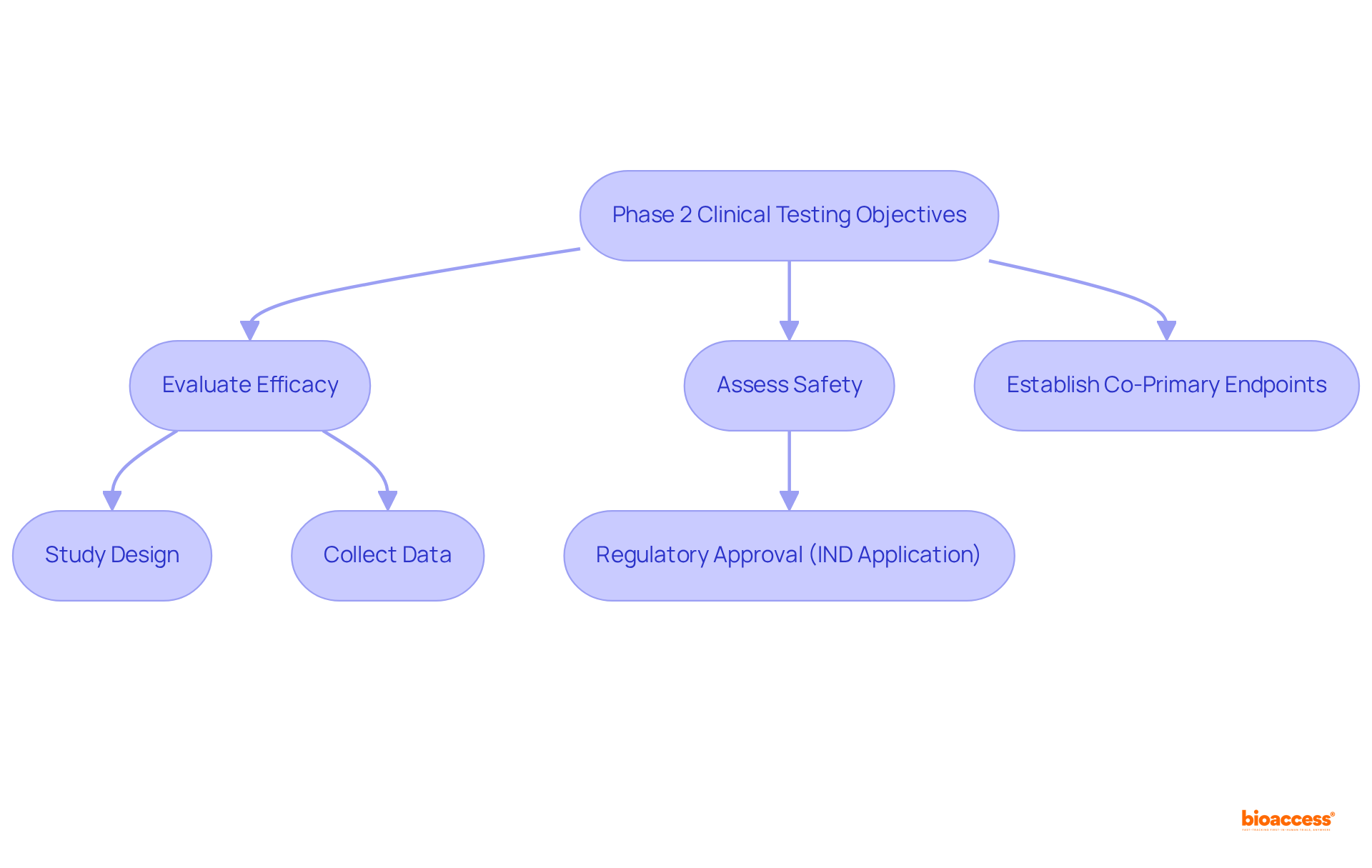
Phase 2 clinical testing typically spans from several months to two years, averaging around 25.7 months in duration. These studies, typically conducted during phase 2 clinical testing, generally involve 100 to 300 participants, and their timelines can be significantly affected by various factors, including:
For instance, studies requiring intricate protocols or larger participant groups may face extended timelines during phase 2 clinical testing due to the need for comprehensive monitoring and data collection. Moreover, the average time required to address protocol issues is approximately 65 days, which can further impede progress in phase 2 clinical testing. Recognizing these variables is essential for stakeholders, as it aids in anticipating potential delays in phase 2 clinical testing and planning accordingly.
Recent evaluations have highlighted that the increasing complexity of research protocols, averaging 2.3 modifications per protocol, has resulted in longer timelines for phase 2 clinical testing. This underscores the necessity for sponsors to optimize procedures wherever possible to enhance efficiency in phase 2 clinical testing. Additionally, the typical cost of a study, particularly during phase 2 clinical testing, can account for 15 to 30% of overall study expenses due to oversight, emphasizing the financial implications of study duration and complexity.
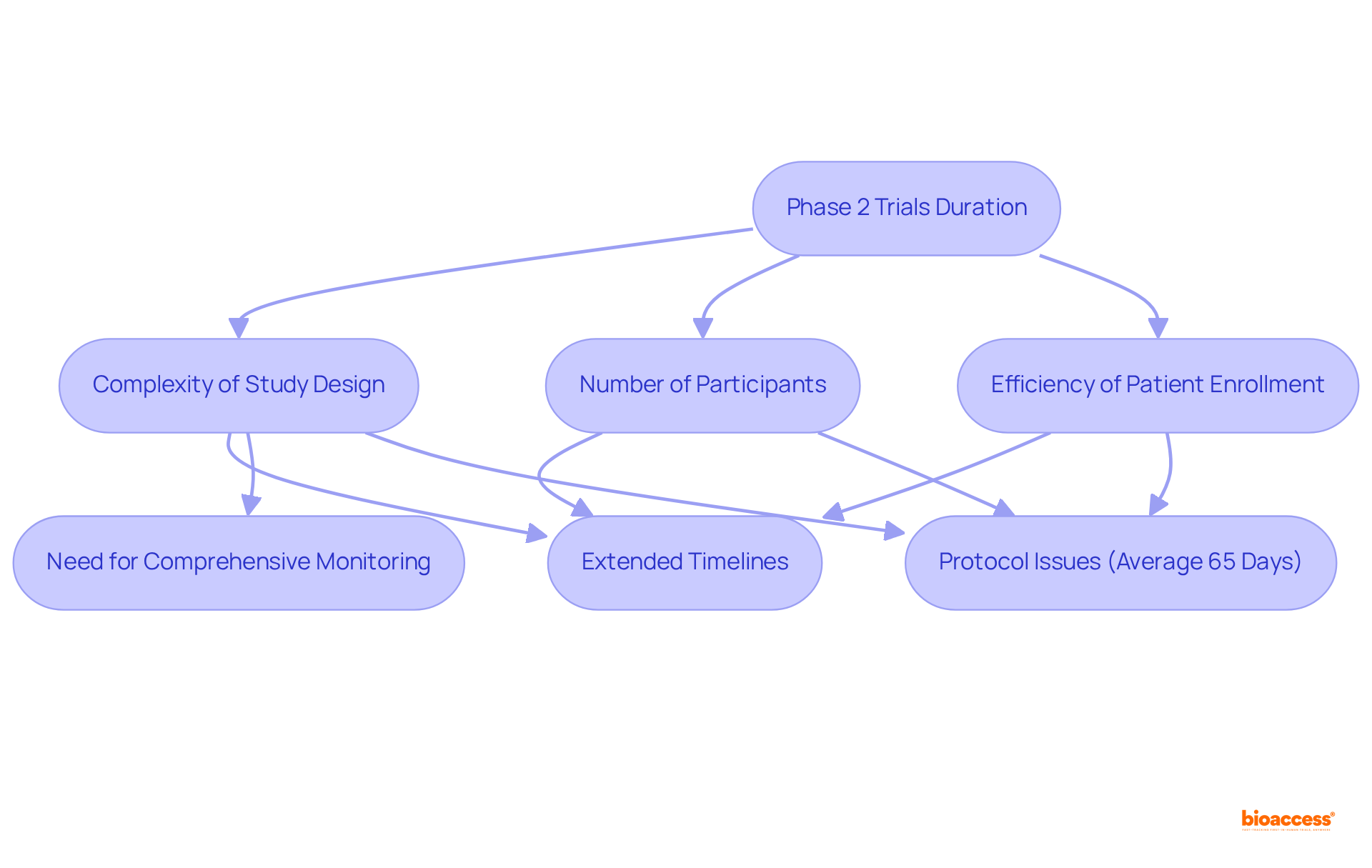
Navigating the regulatory landscape is an essential component of phase 2 clinical testing. Researchers must ensure compliance with both local and international regulations, which includes obtaining necessary approvals from ethics committees and regulatory bodies. Understanding these requirements early in the planning phase is critical, as it can prevent delays and facilitate smoother execution.
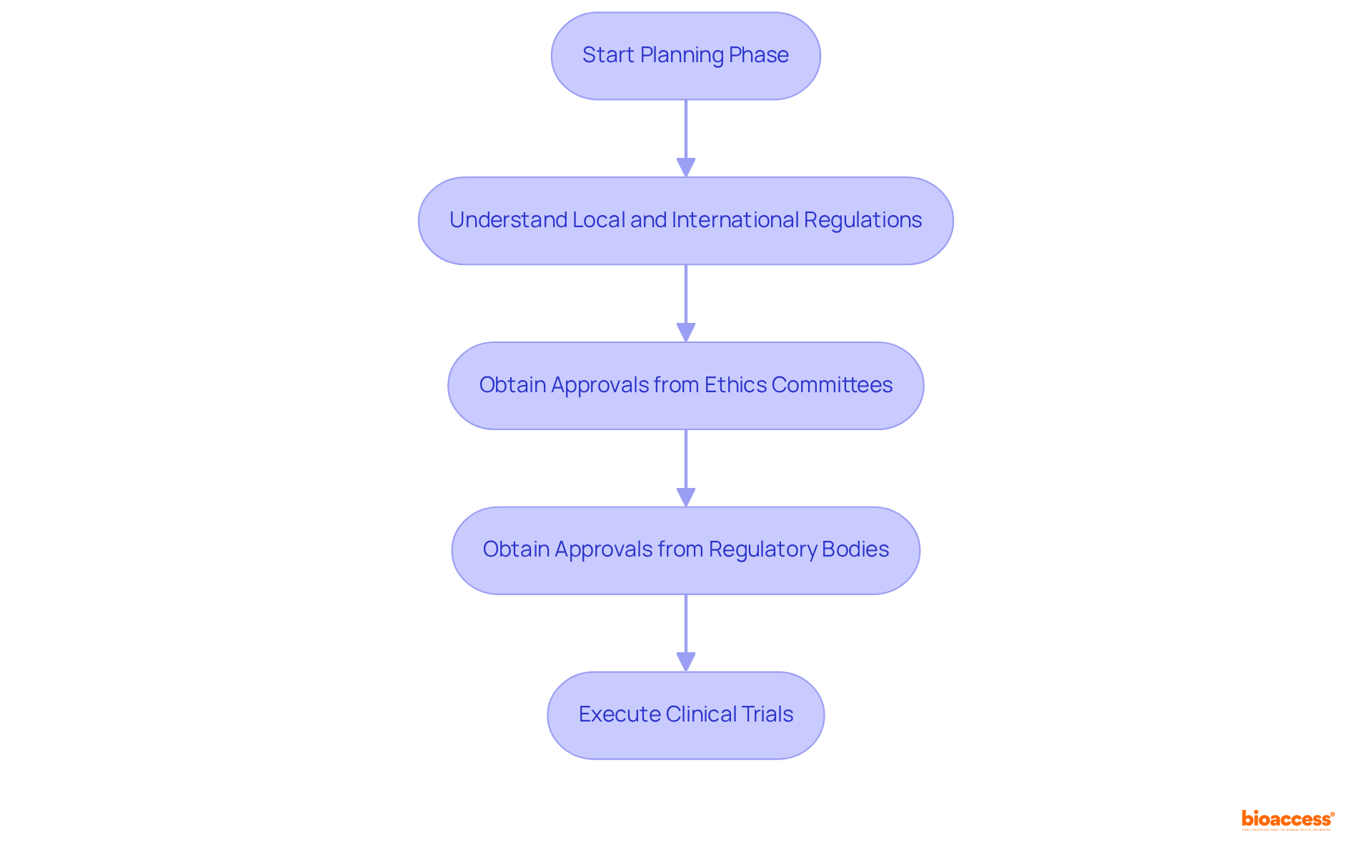
Effective patient enrollment strategies for phase 2 clinical testing hinge on the strategic utilization of digital platforms, which have revolutionized how researchers engage with potential participants. Digital hiring techniques demonstrate a remarkable ability to enhance enrollment efficiency, with studies indicating that online self-referral can account for over 54% of all registrations. As noted by the Research Team, "What they found was remarkable. Internet self-referral completely dominated the hiring landscape, generating 54% of all registrations." This shift reflects a growing trend where individuals actively seek research opportunities online, indicating a desire to partner in the research process.
Engagement with advocacy organizations amplifies outreach efforts by fostering trust and awareness within communities. These groups provide valuable insights into individual perspectives, ensuring that promotional materials resonate with the intended audience. As emphasized by the Research Team, it is essential to "co-create content with patients to avoid jargon and build trust," underscoring the critical nature of clear communication in the hiring process.
Moreover, leveraging local healthcare networks can strengthen connections with potential participants, particularly in underserved areas where traditional methods may fall short. Notably, "51% of store locations in socially vulnerable areas enabled underserved population access," illustrating how local networks can enhance hiring initiatives.
Tailoring hiring strategies to the specific demographics of the target population is imperative. For instance, research indicates that RCTs supported by government funding often achieve higher accrual percentages, highlighting the importance of aligning funding strategies with participant acquisition goals. Additionally, it is crucial to acknowledge that "55% of studies globally do not succeed due to inadequate participation," emphasizing the need for effective hiring strategies. By integrating digital outreach with community engagement and demographic targeting, researchers can significantly boost participation rates to efficiently meet their enrollment objectives for phase 2 clinical testing. Addressing challenges such as lack of awareness, patient distrust, stringent eligibility criteria, and logistical barriers is also essential for enhancing recruitment success.
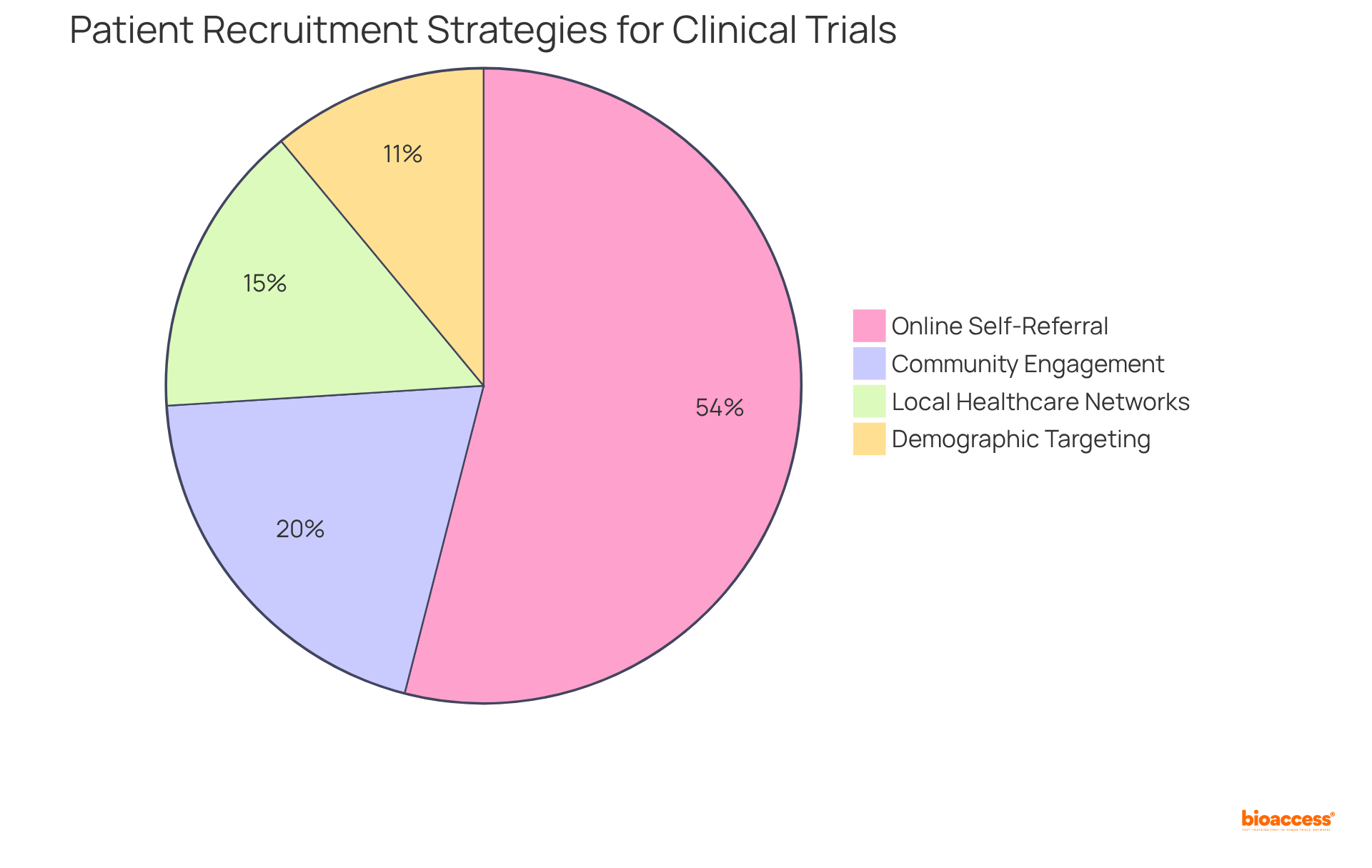
In phase 2 clinical testing, enhancing data collection is paramount, with electronic data capture (EDC), patient-reported outcomes (PROs), and clinical assessments taking center stage. EDC emerges as a crucial tool, streamlining the data collection process and significantly elevating data quality. Research indicates that studies utilizing EDC can achieve data accuracy rates exceeding 90%, a critical factor in ensuring reliable results. By integrating these methodologies, researchers can obtain a holistic understanding of the treatment's efficacy and safety.
Standardizing data collection processes is vital for meeting regulatory requirements and bolstering the trial's integrity. For example, the incorporation of EDC systems facilitates real-time data entry and monitoring, thereby minimizing errors typically associated with traditional paper-based methods. As we approach 2025, the significance of EDC in clinical research continues to escalate, with technological advancements promoting more efficient data management and analysis. This progression not only supports regulatory compliance but also fosters a more agile response to emerging data insights, ultimately improving outcomes for individuals.
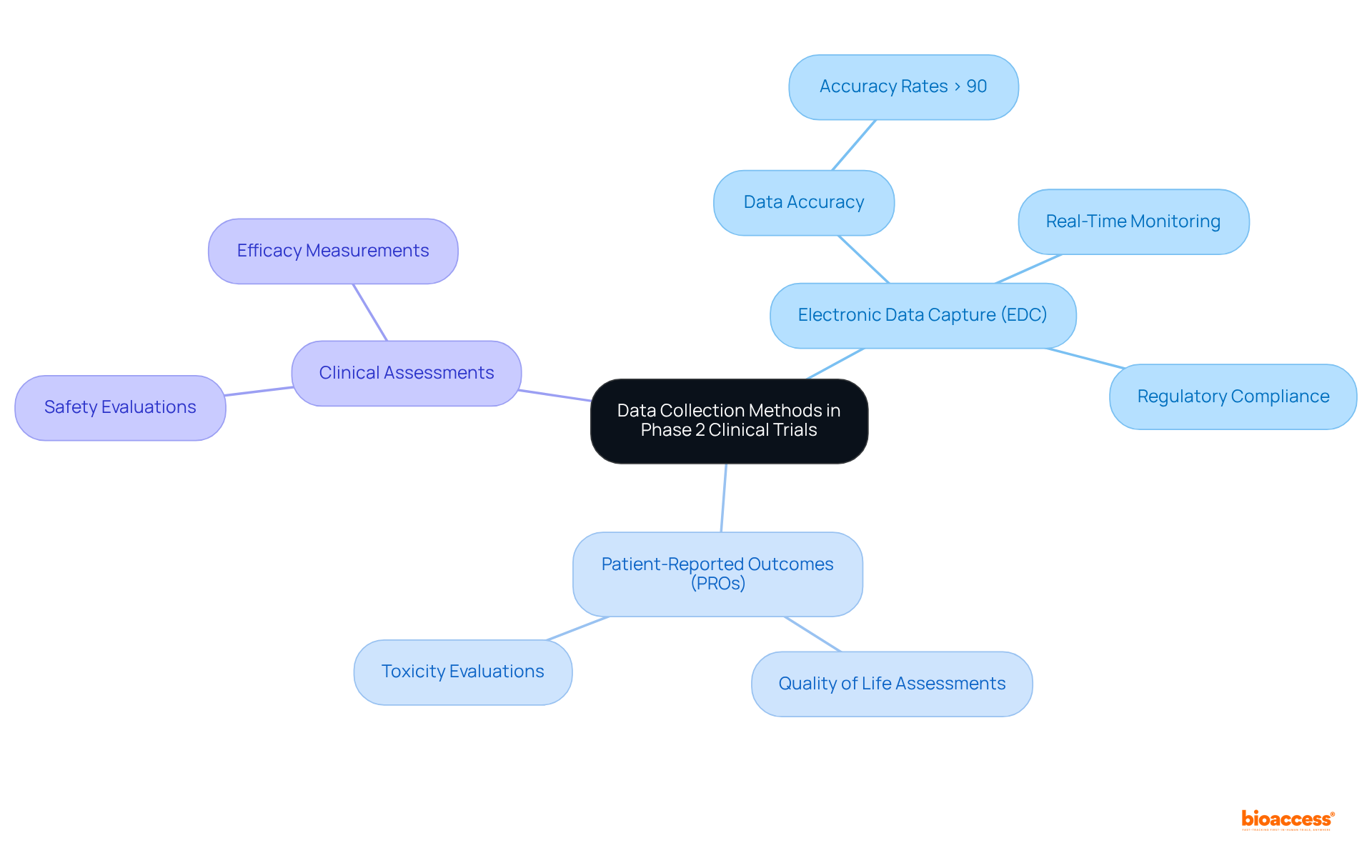
Adaptive study designs empower researchers to modify study parameters based on interim results, such as adjusting dosages or refining patient populations. This intrinsic adaptability can considerably improve testing efficiency and accelerate the approval process.
Studies have shown that adaptive designs can lead to a reduction in the average timeframe for a therapeutic agent to pass through phase 2 clinical testing, which typically spans approximately 12 years. Furthermore, adaptive studies have demonstrated a greater success rate compared to conventional designs, with over 80% of adaptive studies in phase 2 clinical testing ending early at interim analysis due to encouraging results. Notably, 30.7% of drugs fail in phase II trials, underscoring the potential advantages of adaptive designs in improving outcomes.
This adaptability allows researchers to respond to emerging data, optimizing study protocols in real-time and ultimately enhancing patient outcomes. As Philip Pallmann emphasizes, "ADs should no longer be ‘a dream for statisticians only’ but rather a part of every researcher's methodological tool belt."
The incorporation of adaptive designs into medical research represents not just a statistical improvement but a vital methodological progression that can transform the field of drug development. Additionally, adaptive designs can enhance ethical considerations in research studies by enabling more responsive and patient-centered methods.
However, it is essential to acknowledge the potential challenges, such as increased regulatory scrutiny and the need for detailed justifications for adaptations, which must be carefully managed.

Phase 2 clinical testing encounters significant obstacles, particularly in participant enrollment, which can substantially impact study timelines. Over fifty percent of current medical studies struggle to attract participants, with certain categories facing dropout rates as high as 40%. Alarmingly, up to 85% of specific study types experience difficulties in recruitment. This challenge is exacerbated by a widespread lack of awareness regarding medical studies among potential participants; a survey revealed that 85% of cancer patients were unaware of their options at diagnosis, yet 75% expressed willingness to register if informed.
To effectively navigate these challenges, researchers must implement proactive strategies in phase 2 clinical testing. Establishing clear communication with regulatory bodies can streamline processes, while robust data management systems enhance efficiency by aiding in the tracking and analysis of recruitment efforts. Moreover, developing a Subject Enrollment and Retention Plan (SRRP) allows study managers to outline enrollment forecasts and retention strategies, ensuring that objectives are met.
Successful initiatives, such as the Yale Center for Clinical Investigation's 'Help Us Discover' campaign, exemplify this approach by transitioning from individual outreach to a comprehensive strategy that increased volunteer participation and improved minority representation in clinical research. By leveraging technology and innovative outreach techniques, including targeted social media campaigns, researchers can significantly enhance recruitment efforts while maintaining the integrity of their studies.

Effective collaboration among stakeholders—including researchers, sponsors, regulatory bodies, and ethics committees—is crucial for the success of phase 2 clinical testing. Establishing clear roles and responsibilities, maintaining open lines of communication, and fostering a culture of teamwork can significantly enhance the efficiency and effectiveness of the testing process. Organizations that employ collaborative practices can boost productivity by as much as 30%, demonstrating the tangible benefits of teamwork in research.
Statistics indicate that companies integrating stakeholder feedback into product development achieve a 30% higher adoption rate, highlighting the importance of collaborative practices. Furthermore, research reveals that projects characterized by high levels of interaction are 70% more likely to meet their goals, underscoring the direct impact of collaboration on success.
As we look ahead to 2025, the emphasis on teamwork in clinical research is increasingly recognized, with organizations understanding that fostering a culture of collaboration leads to enhanced outcomes. For example, effective communication strategies can result in a 40% reduction in project delays, illustrating how proactive engagement simplifies the process. By prioritizing collaboration and transparent communication, stakeholders can navigate the complexities of phase 2 clinical testing more effectively, ultimately driving medical advancements and improving patient care. Continuous GCP education remains essential for maintaining high standards in trials, ensuring that all participants possess the necessary knowledge to uphold ethical practices and protect participant rights.
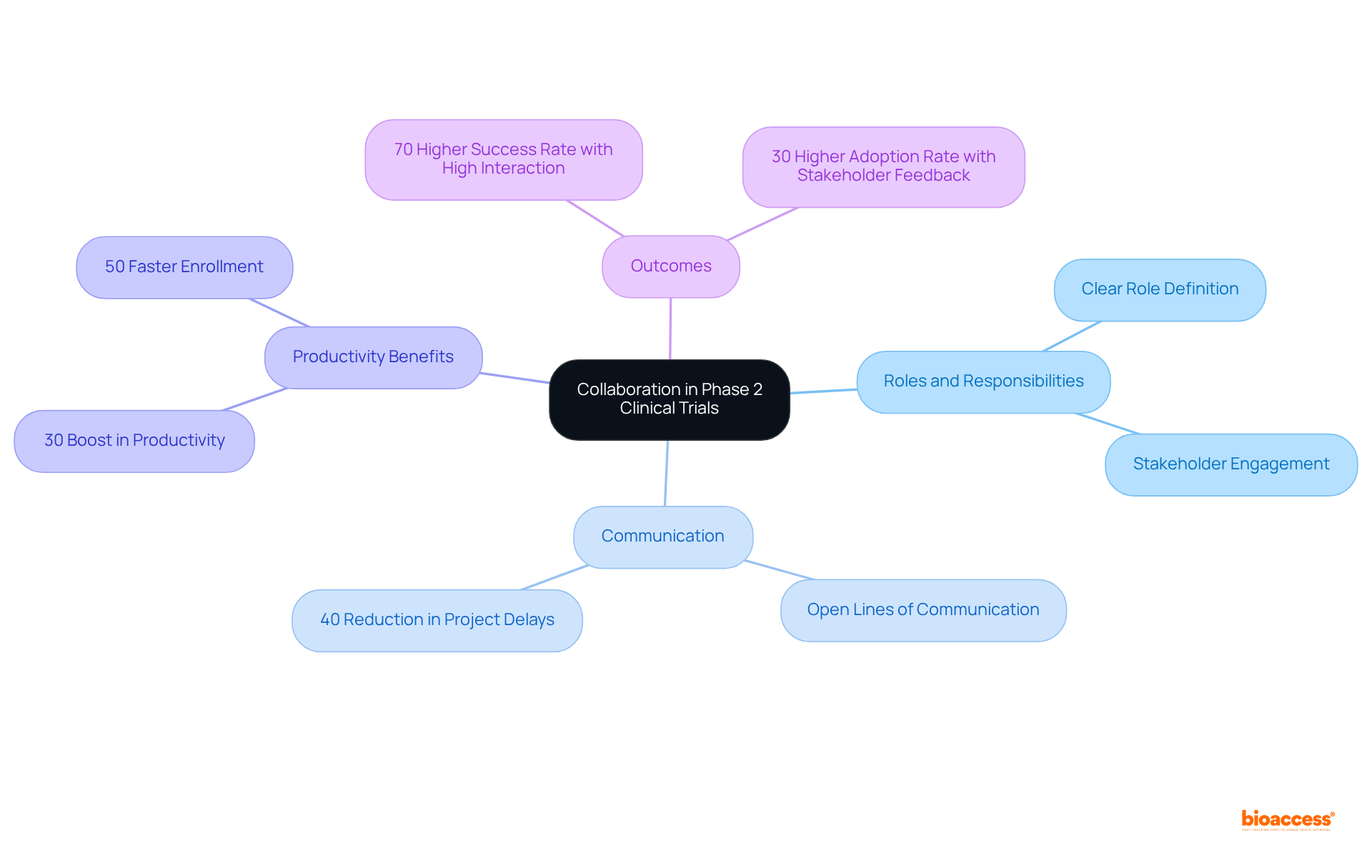
Future trends in phase 2 clinical testing are poised to be significantly shaped by the integration of digital health technologies, including telemedicine and remote monitoring. These innovations not only enhance patient engagement but also facilitate more efficient data collection. Research indicates that over 4,000 registered clinical studies are currently employing wearables and sensors, showcasing a transition towards more integrated methods in clinical research.
With up to 86% of studies failing to meet their enrollment goals, the importance of digital health technologies in enhancing recruitment and retention becomes evident. Furthermore, the incorporation of artificial intelligence (AI) and machine learning in study design and data analysis is anticipated to optimize workflows and enhance results. The global AI in healthcare trials market is projected to expand from USD 1.35 billion in 2024 to USD 2.74 billion by 2030, at a compound annual growth rate (CAGR) of 12.4%, underscoring the increasing reliance on these technologies.
As researchers navigate this evolving landscape, staying informed about these trends will be essential for maintaining a competitive edge in clinical research. As one expert noted, 'The best technology makes participation easier and more meaningful, not more complicated.' Additionally, bioaccess® delivers ethical approvals in 4-6 weeks and ensures enrollment is 50% faster than traditional markets, further emphasizing the advantages of leveraging these technologies.

The insights presented underscore the critical components that contribute to the success of phase 2 clinical testing. By emphasizing strategic planning, regulatory compliance, and innovative methodologies, stakeholders can navigate the complexities of clinical trials with greater efficacy. The integration of technologies such as bioaccess® accelerates processes, ensuring that researchers maintain a competitive edge in the ever-evolving landscape of medical research.
Key arguments throughout the article highlight the significance of:
Each aspect plays a vital role in ensuring that clinical trials are not only efficient but also yield reliable and actionable data. Furthermore, the incorporation of adaptive trial designs and digital health technologies promises to enhance both patient engagement and data collection, paving the way for future advancements in clinical research.
In conclusion, the successful execution of phase 2 clinical trials hinges on a multifaceted approach that prioritizes agility, collaboration, and innovation. As the industry continues to evolve, embracing these insights is essential for researchers aiming to achieve effective outcomes and drive medical advancements. The call to action is clear: stakeholders must harness these strategies to enhance their clinical testing processes and ultimately improve patient care.
What is bioaccess® and how does it impact Phase 2 clinical trials?
bioaccess® accelerates Phase 2 clinical trials by leveraging the regulatory pace of Latin America, diverse patient demographics in the Balkans, and efficient ethical approval procedures in Australia. It significantly shortens trial timelines, with ethical approvals secured in just 4-6 weeks and participant enrollment rates that are 50% quicker than traditional markets.
Why is the agility provided by bioaccess® important in the Medtech, Biopharma, and Radiopharma sectors?
The agility provided by bioaccess® is crucial for maintaining a competitive advantage in rapidly evolving sectors, where timely advancements can greatly impact market success. This speed enhances the efficiency of research processes and meets the industry's growing demand for rapid and reliable research outcomes.
What financial incentives does Colombia offer for R&D in clinical trials?
Colombia offers R&D tax incentives, including a 100% tax deduction for investments in science and technology, making it a financially attractive location for conducting clinical trials.
What are the objectives of Phase 2 clinical testing?
The objectives of Phase 2 clinical testing are to evaluate the effectiveness and safety of treatments among a larger participant group, typically consisting of 25 to 100 individuals. It helps determine whether a treatment meets its intended objectives and identifies potential side effects.
How long do Phase 2 clinical trials typically last?
Phase 2 clinical trials typically last from several months to two years, with an average duration of around 25.7 months.
What factors can affect the duration of Phase 2 clinical trials?
The duration of Phase 2 clinical trials can be affected by the complexity of the study design, the number of participants involved, and the efficiency of patient enrollment.
What is the average time required to address protocol issues in Phase 2 clinical testing?
The average time required to address protocol issues in Phase 2 clinical testing is approximately 65 days.
What are the financial implications of Phase 2 clinical testing?
The typical cost of a study during Phase 2 can account for 15 to 30% of overall study expenses due to oversight, highlighting the financial implications of study duration and complexity.